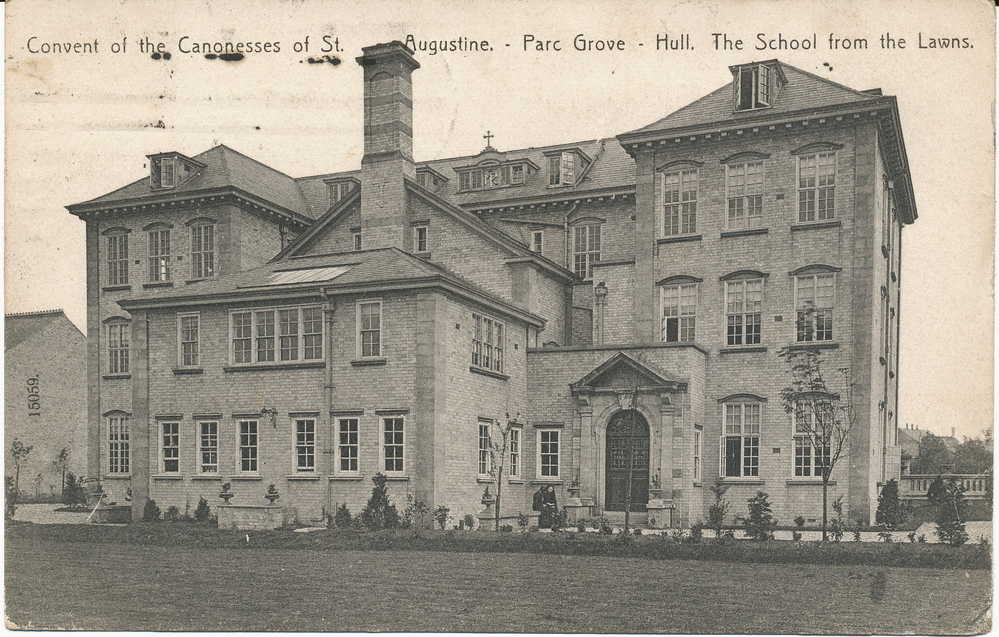‘Teas Provided’ by Norrey Ford [Housewife magazine, Aug 1946]
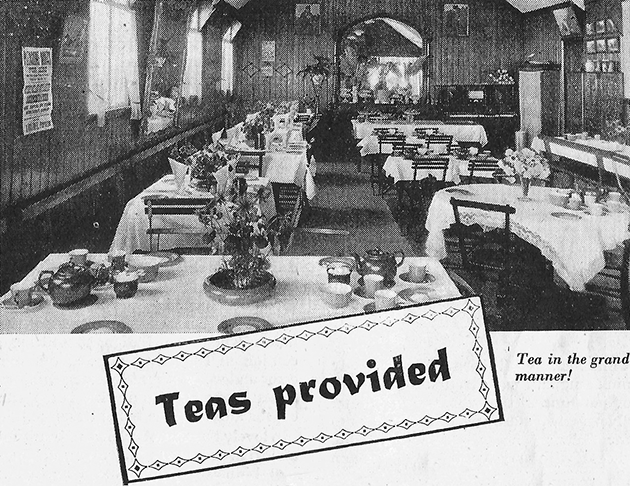
Norrey Ford discovers Britain in the pleasantest way
Like Napoleon’s army, my memory marches on its stomach. A sniff of baking day, and I am miles away in time and space, and itching to rummage out two scuffed pairs of walking shoes.
Towards four o’clock one of us would say ‘Isn’t it about tea-time?’ and we’d look out for one of those boards, home-painted in straggly letters TEAS or, perhaps, TEA’S or even TEE’S.
No modern ‘lounge’ or cretonned tea rooms could lure us—except in stark need—from the footpath. But in a cottage parlour, among the plush frames and dried grasses, the glass lustres and enlarged photo of father-in-the-last-war, we’d tuck into mounds of thickly cut home-baked bread spread with the strong flavoured local butter; under a knitted cosy the brown teapot would squat, as dignified as a broody Rhode Island Red; an old-fashioned pink glass jug would hold the creamy milk, and in an incongruous ‘present from Blackpool’ we’d find fruity home-made jam.
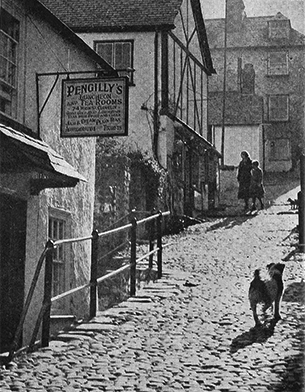 There were thatched cottages in Somerset and Devon where an icy spring slid across the dairy floor in a red-flagged channel—in under one foot-thick wall, out under the other; where, outdoors, the cloth would be spread on the grass, and we could drip clotted cream on to jammy scones and watch the glinting sea. We drank from yellow-lined brown Devon pottery, the teapot with a cheerful motto round its middle: ‘Drown your sorrows in a cup of tea,’ or ‘There’s nowt so funny as folks.’
There were thatched cottages in Somerset and Devon where an icy spring slid across the dairy floor in a red-flagged channel—in under one foot-thick wall, out under the other; where, outdoors, the cloth would be spread on the grass, and we could drip clotted cream on to jammy scones and watch the glinting sea. We drank from yellow-lined brown Devon pottery, the teapot with a cheerful motto round its middle: ‘Drown your sorrows in a cup of tea,’ or ‘There’s nowt so funny as folks.’
Derbyshire teas are Chiefly Memorable, as the authors of 1066 say, for A Good Thing, Bakewell Tarts. Whose greedy pink tongue, I wonder, first found a dab of jam under the soft yellow filling?
Nottinghamshire teas introduced us to the Colwick cheese, a round flat milk cheese with a layer of clotted cream through the waistline. And a dreadful compound of milk cheese blended with chopped sage, a sickly green delicacy the name of which, happily, is forgotten.
It is when the border is crossed into Yorkshire that tea develops into a rite, the pinnacle of the day’s feeding.
Our Easter walking party was caught by a sudden April snow storm on an exposed moorland road. A small grey stone-built inn, crouching with its back against the tearing winds, promised shelter. ‘Eeh, cum and have a warm and a bite of summat t’eat,’ said the hostess comfortably, as we struggled with sou’westers and capes. We filled the tiny parlour and overflowed into her kitchen.
A kettle hummed on a hook over the fire. The well-blacked grate and a shiny copper kettle (‘for best’) twinkled back at the fire. The oak settle and corner cupboards shone with the patina experts value, soaked into the wood through generations of warm fires, good cooking, and proud housewifery. Hams, neatly shrouded in snowy cloths, hung above.
The bite o’ summat proved to be thick rashers of home-cured ham, baked in a covered dish in the oven. A huge old pan sizzled with a dozen eggs at a frying. There were hot muffins to dip in the gravy. To follow came apple tart and cheese, curd cheesecakes, the curd mixed with sugar and spices, currants and lemon; ‘fat rascals’ and heavy slices of currant bread, served with cheese.
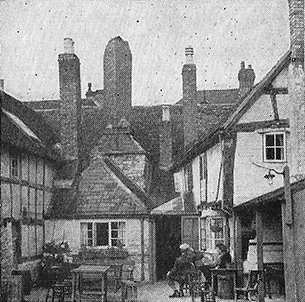 At Ruswarp, on the Esk near Whitby, there is a house where ‘as much as you can eat for a shilling’ was the tariff. Nine of us inadvertently sat down at a table spread for fourteen—and ate everything! ‘Nay, lass,’ beamed the mistress of the house when the indignant fourteen, coming in later, had pointed out our error and we proffered fourteen shillings to settle our bill, ‘as muckle as tha’ can eat for a bob. Nine bob’s t’chairge.’
At Ruswarp, on the Esk near Whitby, there is a house where ‘as much as you can eat for a shilling’ was the tariff. Nine of us inadvertently sat down at a table spread for fourteen—and ate everything! ‘Nay, lass,’ beamed the mistress of the house when the indignant fourteen, coming in later, had pointed out our error and we proffered fourteen shillings to settle our bill, ‘as muckle as tha’ can eat for a bob. Nine bob’s t’chairge.’
In lovely Northumberland, so beautiful and so little known, they give you ‘singing hinnies.’ And how extravagant Cumberland rum butter tastes!
A mile or so beyond Gretna Green smithy, tea was laid in the stiff parlour-cum-bedroom of a tiny Scottish cottage. Fourteen varieties of cake and scone followed each other on to the mahogany centre-leg table. Scones, griddle cakes, pancakes, oatcakes, shortbread, bannock.
A prim white counterpaned four-poster used most of the space; a tapestry- topped night commode, black horse- hair chairs with decent starched crochet covers on their legs—an enormous steel engraving of the Death of Someone—I forget who—awed us. It was a room to be born in, to die in—but to munch oatcakes and have a third cup of tea seemed sheer irreverence.
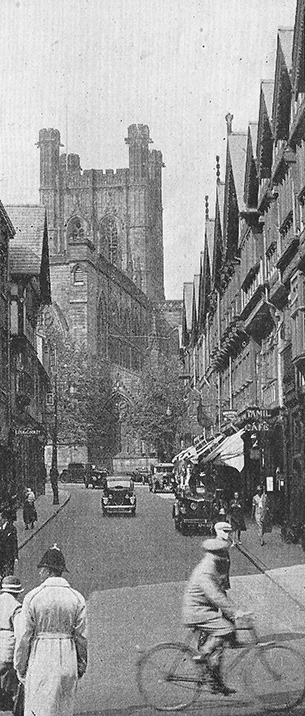 In all Scotland you can get a good cup of tea and a meal fit for a man off the heather—and a woman, too. When there’s dark amber heather honey on the table, greed becomes a plain duty to oneself.
In all Scotland you can get a good cup of tea and a meal fit for a man off the heather—and a woman, too. When there’s dark amber heather honey on the table, greed becomes a plain duty to oneself.
Wales, gastronomically speaking, is to us a desert of bread and margarine and seedcake. Without doubt there are delicious Welsh teacakes fed to famished walkers somewhere—but we have never been there. And on Sundays the bread is stale, for they cut it on Saturday night.
In the Irish-speaking west of Eire the scenery is magnificent; the black cliffs of Moher drop sheer into the Atlantic. The lime white mountains of Clare strike up into a sky of softest Irish blue.
But the food is frankly poor. Almost the only catering is at hotels, which may be forty miles apart. At Skibbereen the hot water came out of the cold tap, the cold out of the hot tap. At Cahirciveen the leg of the bed was supported by two books—one a Bible.
At Killary Bay we ordered breakfast for eight a.m. ‘Ock’ said Herself, ‘what do you want to be bothering yourselves with them times for? Sure, take it easy and have your breakfast at nine.’
We gave in. Breakfast was finally served at ten o’clock, as Herself had intended.
Eggs and bacon are the visitors’ staple dish for any meal in the day, but at mid-day potatoes are added, boiled in their jackets and served on a side plate. At tea, three kinds of bread appear, called ‘the wheaten,’ ‘the soda,’ and ‘the barley.’ They are not baked in loaves, but in thin flat cakes.
The tea an Irishwoman brews is strong and black, sickly with sugar. Protests about not taking sugar are waved aside as polite fiction, hospitably to be ignored. At Ballybunion I emptied a cupful into a neatly enclosed yard containing exactly one pig and one arum lily.
Two pairs of walking shoes have a post-war plan that includes everything from the coombes of Somerset to the fells of Cumberland. Till it can be put into practice, an ordinance map and a well-thumbed copy of Florence White’s wonderful Good Things in England keep memory as fresh as a new-baked scone.

